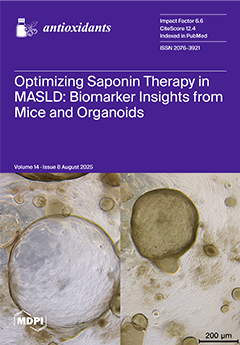Carnosic acid (CA), a natural phenolic terpenoid compound, is widely distributed in plants such as sage and rosemary, and exhibits a strong antioxidant capacity. The aim of this study was to investigate the effects of different levels of CA on growth performance, antioxidant capacity, and intestinal health of yellow-feathered broilers, and then to determine the optimal dose of CA to promote sustainable broiler production. A total of 384 1-day-old yellow-feathered broilers were randomly allocated into six treatment groups with eight replicates per group and eight birds per replicate pen. The control group (CON) was fed a basal diet and the CA treated groups (CA5, CA10, CA20, CA40, and CA80) were fed diets given different doses of CA (5, 10, 20, 40, and 80 mg/kg), respectively, for 53 days (1~21 d and 22~53 d). The results showed that, in the later stages of the experiment, supplementation with 10, 20, and 40 mg/kg of CA increased (
p < 0.05) the final body weight and average daily gain. Morphometric analyses of the jejunum showed that supplementation of CA increased (
p < 0.05) the ratio of villus height to crypt depth (V/C). Antioxidant indices revealed that CA significantly reduced MDA levels in plasma, liver, and jejunum, while enhancing activities of GSH-Px, T-SOD, and T-AOC (
p < 0.05). Moreover, CA upregulated hepatic
Nrf2,
HO-1,
GSH-Px, and
GSR expression via downregulated
Keap1. The analysis of intestinal microbiota showed that CA increased (
p < 0.05) microbial α diversity (Ace, Chao, and Sobs indices) and increased (
p < 0.05) beneficial bacteria, such as
Streptococcus,
Enterococcus, and
Phascolarctobacterium. In conclusion, CA improves growth performance, antioxidant capacity, intestinal health, and gut microbial diversity in broilers. Under the conditions of this experiment, quadratic regressions for different variables showed that the optimal range for supplemental CA in chicken’s diet was 19.11~76.85 mg/kg. Combined with experimental observation and regression analysis, the optimal level of supplementation was 40 mg/kg.
Full article






